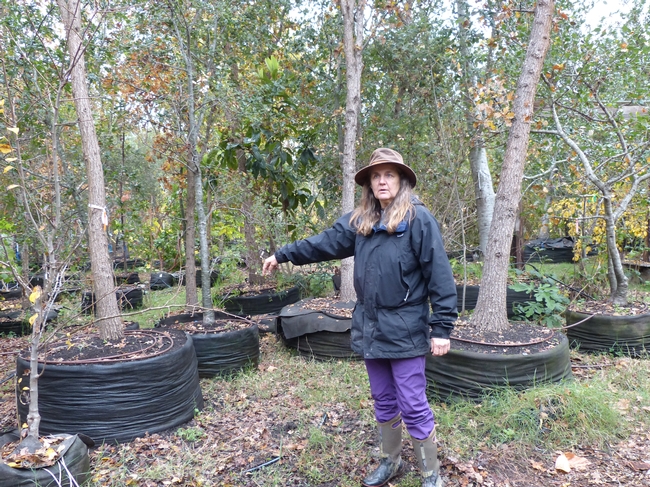by Corinne Yoshihara

Master Gardeners recently had a presentation on a “how to” about growing oak trees by Jean Wheeler of Main Street Trees. Jean described her tree growing methods and led a tour of her three acre tree farm in Napa.
If you want to grow trees from acorns, collect acorns in early fall as they are just starting to drop from the trees. Acorns are ripe when they turn from green to brown and detach easily from their caps. Select the healthiest acorns which are ones picked or shaken from the tree. Acorns on the ground and in the sun or with caps on are likely not viable. Select acorns that are uniformly brown in color, firm and intact with no holes or cracks. Wash the acorns in a container of water and discard those that float. Put dry acorns in Ziploc bags and place in a refrigerator. Since acorns are alive and respiring, they generate heat so avoid storing too many together. Plant the acorns in the growing season following collection.
One important point to consider when planting oaks is the source of the acorns. Since local oak populations have adapted to their areas, it is best to collect acorns as close as possible to the intended planting site. Even oaks of the same species will vary in their genetic traits from site to site.
You may want to follow these steps to grow oak trees in containers prior to planting in the yard. Alternatively, you may choose to plant acorns directly in the ground.
Plant the acorns in deep plastic pots. The acorns grow in the small, deep pots for a year. Seedlings are transplanted to progressively larger-sized deep, pots where they remain for a few more years before being planted in bags.
Jean prefers to grow trees in grow bags. Grow bags offer several advantages over plastic pots. The primary advantage is that the fabric of the bag discourages long, circling roots. When the large roots reach the fabric, the root tips dry out due to contact with dry air (“air pruning”). In response to this stop in growth, other areas of the root send out many, fine roots resulting in fewer circling roots and a very fibrous root system. The finer roots are more efficient at water and nutrient uptake. Another advantage of grow bags is less root burn. The roots at the edge of the bag do not burn from the sun's heat as they do in black plastic pots. Instead, roots at the periphery are cooled as water in the soil evaporates.
Tree size and water needs are easily accommodated with grow bags. The trees are transferred to larger grow bags as they mature and are watered by irrigation lines for ten minutes twice a day. The water requirement for each tree is adjusted by emitter number and spacing.
Since young oak trees seem to pop up everywhere, you may be tempted to grow an oak by transplanting oak seedlings. Although this is an option, it is better to grow oaks from acorns than to dig up a small tree. Seedlings quickly develop long tap roots (remember trying to pull them out?) which may be damaged in the process. If you want to transplant a seedling, Jean suggests doing so over a two year period. In the first year, do a partial unearthing of the tree removing one half to three quarters of the soil around the roots and replacing the soil to allow the smaller roots to regenerate. Dig out the tree completely in the second year. Acorns seem more appealing.
Oaks are beautiful trees that provide shade and support native wildlife. Before planting one, determine if you have the space and conditions for such a large and long-lived tree.